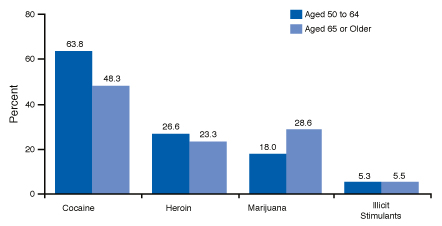In the ER: Older Adults & Illicit Drug Use
By Kristin Blank
The use of illicit drugs like marijuana, cocaine, and heroin may be most commonly associated with young adults. But recent SAMHSA data show that rates of illicit drug use among adults age 50 to 59 increased from 2.7 percent in 2002 to 4.6 percent in 2008.
That same year, an estimated 118,495 emergency room (ER) visits involved illicit drug use by older adults (people age 50 or older), according to Emergency Department Visits Involving Illicit Drug Use by Older Adults: 2008 from SAMHSA’s Drug Abuse Warning Network (DAWN).
To be a DAWN case, an ER visit must have involved a drug, either as the direct cause of the visit or as a contributing factor.
Cocaine was the illicit drug most commonly reported in ER visits among older adults in 2008 (63.0 percent), followed by heroin (26.5 percent), marijuana (18.5 percent), and illicit stimulants (5.3 percent). (See chart for a more detailed breakdown by age group.)
Nearly one-third (31.1 percent) of visits that involved illicit drugs also involved alcohol.
Males made the majority of ER visits involving illicit drug use by older adults (71.2 percent).
More than half were made by adults age 50 to 54 (58.2 percent). Visits by adults age 55 to 59 accounted for 25.7 percent of such visits, whereas 11.1 percent were made by adults age 60 to 64.
ER visits made by adults age 50 to 64 were more likely to involve cocaine than visits made by those age 65 or older (63.8 versus 48.3 percent).
Less than half of ER visits involving illicit drug use by older adults (48.1 percent) resulted in evidence of followup care (admission to an inpatient unit in the hospital, transfer to another health care facility, or referral to a detoxification program or substance abuse treatment).
However, an estimated 42,285 ER visits involving illicit drug use by older adults (35.7 percent) resulted in hospitalization. Of these, 25,333 (59.9 percent) were admitted into an “other” inpatient unit; 6,484 (15.3 percent) were admitted to a psychiatric unit; 5,746 (13.6 percent) required intensive or critical care; and 4,356 (10.3 percent) were admitted to a chemical dependency or detoxification unit.
Download Emergency Department Visits Involving Illicit Drug Use by Older Adults: 2008 from SAMHSA’s Center for Behavioral Health Statistics and Quality.
Enlarge image
 Source: SAMHSA, Center for Behavioral Health Statistics and Quality (September 9, 2010). Figure 2. Emergency Department (ED) Visits Involving Selected Illicit Drugs by Adults Aged 50 or Older, by Age Group: 2008. The DAWN Report: Emergency Department Visits Involving Illicit Drug Use by Older Adults: 2008. Rockville, MD.
Source: SAMHSA, Center for Behavioral Health Statistics and Quality (September 9, 2010). Figure 2. Emergency Department (ED) Visits Involving Selected Illicit Drugs by Adults Aged 50 or Older, by Age Group: 2008. The DAWN Report: Emergency Department Visits Involving Illicit Drug Use by Older Adults: 2008. Rockville, MD.
Text only